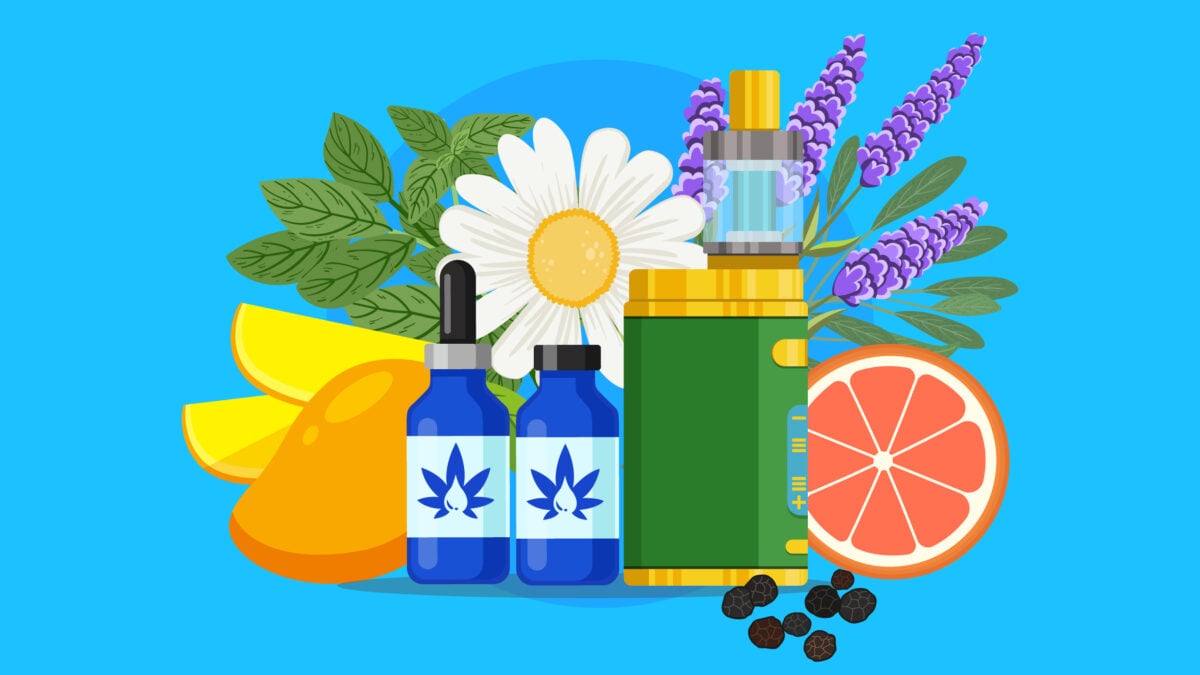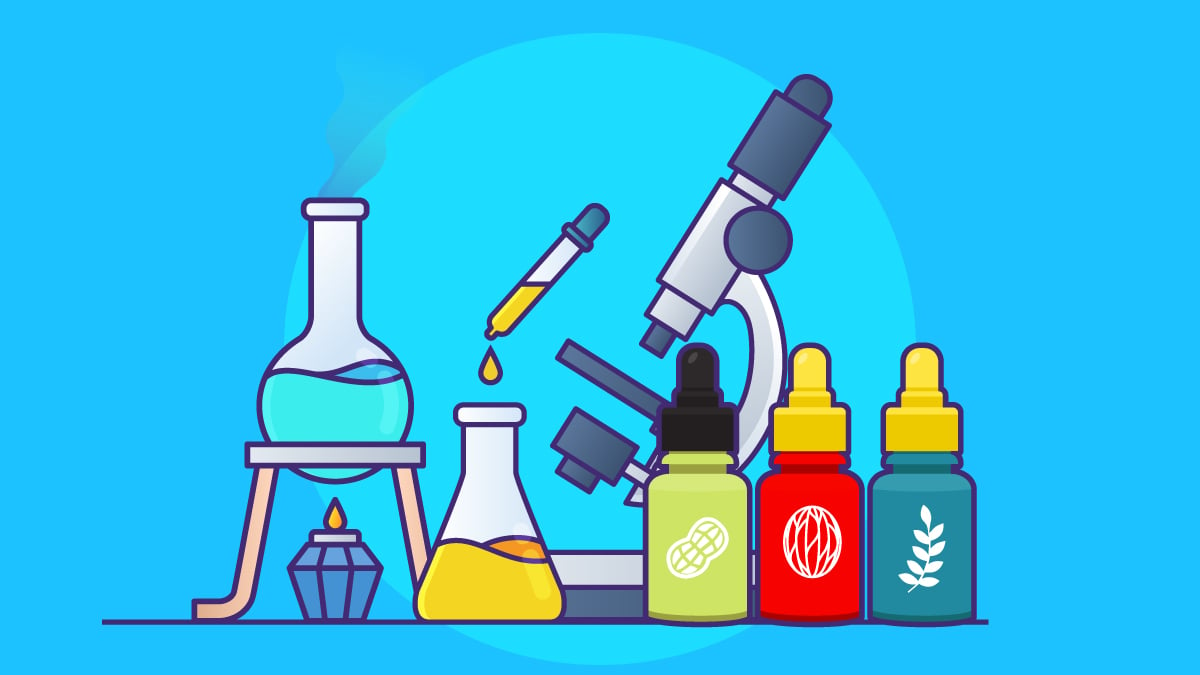How to Use Terpenes

When people want to personalize their cannabis experience, they mostly look for a certain CBD to THC ratio. However, that’s not the only thing that can influence the way we process cannabis.
A group of compounds called terpenes is responsible for the aroma, flavor, and effect profile of cannabis extracts.
Liquid terpenes are a great way to reintroduce flavor to products like CBD isolate and contribute to a phenomenon called the entourage effect.
Here’s everything you need to know about terpenes.
A Brief Overview of Terpenes
Terpenes are aromatic compounds that exist in most plants but are usually associated with cannabis. These fragrant fusions are responsible for the taste and smell of our favorite cannabis strains. In fact, the scent they give off often makes us associate those strains with other plants that contain the same terpene.
For example, pinene is also found in pine, limonene is found in citrus fruits, and myrcene is found in mangos. Therefore, cannabis plants that produce any of these terpenes will share some of the aromatic profiles of these plants.
Of course, the function of terpenes isn’t just to make cannabis smell good. Their most important purpose is arguably the one they have during the growth cycle of the plant. Namely, they protect it from insects, fungus, and bacteria, among other things.
Many of them have also been found to enhance the effect of cannabis by helping the human body absorb various cannabinoids or providing their own set of effects.
How to Use Terpenes
As we’ve established, terpenes exist in the resin of cannabis and many other plants. They are extracted through the process of steam distillation or vaporization. Basically, we take the raw plant materials and steam them in a distiller. The condensation escapes through a tube where the particles clump together to form a liquid.
After the fluid goes through a refining process, the result is pure terpene. These terpene concentrates can then be mixed into any cannabis product you like to enhance the flavor and support the entourage effect.
Diluting Terpenes
When working with a pure terpene product, we will want to dilute it before applying it to cannabis. That’s especially important for people who have never used terpenes and don’t know how powerful they are!
Even the tiniest amount of terpene can cause a big change in the qualities of a cannabis extract. Two drops of pinene can make the whole room smell like a forest. Obviously, any aroma can become overwhelming if you accidentally add too much of it.
That’s why we have to dilute the terpene concentrate in oils. After all, these aromatic compounds are oils. So while other oils and even alcohol may be suitable for dilution, water-based liquids most certainly are not.
When in doubt, go for coconut oil, PG (propylene glycol), or PEG (polyethylene glycol). Olive, jojoba, hemp, and MCT oils will also mix with the terpene of your choice as long as you don’t go over a 1:1 ratio. Generally speaking, those new to terpenes should start with a 1% concentration and never go over 10%.
Heat will help those oils blend, but we must be mindful not to let the mixture darken. Moreover, all terpenes have different vaporization points, so they’ll evaporate if we apply too much heat. When the mixture is ready, we can either vape it right away or mix it with distillate. However, if we want to have the most flavorful experience, it’s best to get an adjustable temperature vape.
How to Use Terpenes in a Vape
Terpenes are activated by heat, so vaping them is a great idea. But as we have established, each terpene vaporizes at a different temperature. For example, pinene evaporates at 311 degrees Fahrenheit. Myrcene goes off at 332 degrees and limonene at 348 degrees Fahrenheit. For reference, THC vaporizes at 314 degrees, and CBD evaporates in the 320–356-degree range depending on the strain.
Ultimately, terpenes that vaporize at a lower heat tend to give a very productive and clarifying high. Those with an evaporating point in the 330–370-degrees range have the classic giggly effect. And anything that kicks in in the 370–430-degree range generally makes users sleepy and euphoric. One example of that is linalool, commonly found in lavender and has a vaporization point of 388 degrees Fahrenheit.
So what does all that mean for us? Well, broadly speaking, it tells us when a certain terpene will kick in. You see, in a joint or a bong, everything is combusting at the same temperature. Therefore, we lose some of the subtleties we might have gotten with an adjustable temperature vaporizer.
Of course, simply having an adjustable vaporizer doesn’t teach us how to use terpenes in a vape. Basically, if you want to experience the full range of the terpenes, you added to your cannabis, start with the lowest temperature and work your way up.
Some people even fire up their vape on the lowest setting and turn it off after getting everything from the first terpene. Then, the next time they use the vape, they also amp up the heat. That makes the cartridge last much longer and produce a different effect every time.
Drip the Terpene Onto Your Bud or Pipe Bowl
Certain products can take a drop or two of pure terpenes, though doing small batch testing is always a good idea. Still, if you wanted to freshen up your flower, a drop or two is all you need! However, as discussed, mixing several terpenes with different vaporization points may not have the best effect.
So what if we wanted to add pure terpene concentrate to our bud? Well, one way to do so would be to add a drop or two into our grinder. After we grind the flower, it’ll pick up the aroma, allowing us to experience the full flavor profile when we smoke it.
Similarly, we might add the same amount of terpene into our pipe bowl before adding cannabis in there. But, of course, we must keep in mind that different terpenes naturally go with different cannabis strains. For example, linalool — remember, the terpene that’s also found in lavender — tends to go with strains that have the word “purple” in it. That’s because those strains tend to have it in some ratio already.
Dip Your Dab Into the Terpene
Combining terpenes with shatter is a much less intricate process than most people think. It’s just a matter of dipping your dab into a terpene or dropping some directly into the shatter. You’d need to do it before the shatter fully dries.
Again, we recommend sticking to the “drop or two per gram of product” ratio. Then, after dropping the terpene, use a small tool to break the shatter and mix it up before using it as you normally would.
Non-Cannabis Uses
Lastly, we ought to point out that terpenes don’t have to be mixed in with cannabis. For one, we can also vape them on their own, without nicotine or cannabis! Better still, they can bring a wonderful flavor to any drink or meal.
As always, it’s best to experiment with the amount of terpene you’re using. But remember, since terpenes are oils, you won’t be able to mix them into water-based beverages. Of course, they’ll still bring an interesting aroma to any drink, but they may float to the top. In any case, we recommend testing them out primarily with alcoholic cocktails.
Lastly, we should also mention cosmetic uses. As we have mentioned, terpenes are the key ingredients in pretty much every scented product you can think of. So if you ever decide to make your own perfume or skincare products, you’ll want to know your favorite terpenes and how they work together ahead of time.
So Why Do We Need to Know How to Use Terpenes?
Most beginner cannabis users think that it’s all about CBD and THC — but that couldn’t be further from the truth. Many other things can influence our experience with cannabis. Terpenes are only one part of that equation.
Even still, we still don’t know the full extent of what terpenes do for us. Of course, we know that they add flavor and aroma, but there’s evidence pointing to the fact that many of them have other benefits as well. For example, caryophyllene has a spicy flavor similar to the taste of black pepper, cloves, and cinnamon.
Other terpenes have different strengths. For example, limonene has a distinctly uplifting and energizing effect. But if you wanted to highlight its citrusy aroma, you’d mix it with terpinolene. On the other hand, if you wanted to relax, you’d use pinene or myrcene. So you see, learning how to use terpenes lets you tailor your cannabis experience precisely to your taste.


